Long time lurker, first time poster. I am starting an autoflower garden and was wondering if others have had any negative outcomes from periodically turning on lights during an 8 hour dark period. I know the risks while growing a photoperiod plant, but was thinking it wouldn't bother an auto???
Navigation
Install the app
How to install the app on iOS
How To Use Progressive Web App aka PWA On 420 Magazine Forum
Note: This feature may not be available in some browsers.
More options
You are using an out of date browser. It may not display this or other websites correctly.
You should upgrade or use an alternative browser.
You should upgrade or use an alternative browser.
Lights on at night in autoflower garden
- Thread starter RVCGrower
- Start date
Scientific
New Member
Hi lurker/poster RVCG -- That's an interesting question. I suspect that the answer is that because autos don't care about day length (you can leave the light on 24 h a day if you want), having the light go on and off during the 8 hour dark period shouldn't make any difference (other than encouraging them to photosynthesize a little more). But I doubt if anyone can say for sure unless they've done it.
- Thread starter
- #3
Thanks for the response - that was my thought process as well. I am growing in a cold area and normally have to have some heat on in my tent during lights out at night. To avoid the need for nighttime heat I was thinking about switching to a lights on schedule at night and dark during the day and there might be times when I want to do some work on the garden during my day/plants night.Hi lurker/poster RVCG -- That's an interesting question. I suspect that the answer is that because autos don't care about day length (you can leave the light on 24 h a day if you want), having the light go on and off during the 8 hour dark period shouldn't make any difference (other than encouraging them to photosynthesize a little more). But I doubt if anyone can say for sure unless they've done it.
Scientific
New Member
Thanks for the response - that was my thought process as well. I am growing in a cold area and normally have to have some heat on in my tent during lights out at night. To avoid the need for nighttime heat I was thinking about switching to a lights on schedule at night and dark during the day and there might be times when I want to do some work on the garden during my day/plants night.
With autos, if heat is a problem, I'd suggest just leaving the lights on all the time, 24 hours a day. They will love it in my experience.
- Thread starter
- #5
I had been debating that. I keep seeing arguments for and against, but sounds like you have had some success. Can't hurt to give it a try. I normally run a recirculating coco system and don't water at night. Wonder if this would also give an opportunity for another watering cycle...With autos, if heat is a problem, I'd suggest just leaving the lights on all the time, 24 hours a day. They will love it in my experience.
Scientific
New Member
I had been debating that. I keep seeing arguments for and against, but sounds like you have had some success. Can't hurt to give it a try. I normally run a recirculating coco system and don't water at night. Wonder if this would also give an opportunity for another watering cycle...
A lot of people seem to feel that plants need to "sleep," but in my experience, 24/0 works with autos.
An opportunity for more watering and more growth!

Scientific
New Member
I'm working on a recirculating coco system and would love to see yours if you can post some pics.
Oldbear
Well-Known Member
Long time lurker, first time poster. I am starting an autoflower garden and was wondering if others have had any negative outcomes from periodically turning on lights during an 8 hour dark period. I know the risks while growing a photoperiod plant, but was thinking it wouldn't bother an auto???
I think I would flip to 18/6 and move the 6 to when I was least likely to work on the plants. Give lots of access time.
Let your babies sleep

- Thread starter
- #9
Sure thing, I will snap a few photos this weekend when I get setup for my next grow. It is a small 3x2 tent and I only run 1 or 2 plants at a time, but I am happy with it. I have controllers for temp and humidity and a pH controller/peristaltic pump for the res. Humidifier and res are plumbed to float valves. I drain res and nute up once a week, other than that it is set and forget.I'm working on a recirculating coco system and would love to see yours if you can post some pics.
Scientific
New Member
I drain res and nute up once a week, other than that it is set and forget.
That's exactly what I'm aiming for.
- Thread starter
- #11
As mentioned above it seems like an unsettled debate for autos; lots of opinions and experience in both camps. There are a few threads with 24/0, 20/4, 18/6 with side by side grow comparisons and some folks reporting better yield with 24/0 and others better with 18/6. One thread felt 18/6 to develop roots until flowering started then switch to 24/0 gave then the best results...I think I would flip to 18/6 and move the 6 to when I was least likely to work on the plants. Give lots of access time.
Let your babies sleep
In my case it isn't really about seeking that last bit of yield, just avoiding running a heater at night.
- Thread starter
- #12
As promised here is my setup. I grow in a small 3x2x5 tent. It's a tough space to grow in, but I do OK. I have the tent up on a short table/platform and a hole cut in the bottom of the tent and table so the catch pan can sit right on the bottom, lights are as close to the top as I can get them (need all the growing space I can get). The catch pan is fitted with a flood/drain table drain nipple and the return hose comes out underneath. I have included a photo with the plant in place (just stuck a new seed in) and without the plant. In the photo without the plant you can see the irrigation ring (just made from Rainbird irrigation line and barbs) and the pan (just a fluid drain pan from auto store). I bucked off some rings from a PVC pipe to put in the pan and keep the pot out of and standing water in the bottom of the pan, though once the roots get down into it they suck any water up pretty quickly. My res is just a 5 gal bucket fitted with another flood table drain at the bottom on the side and I Tee off with another line and valve that goes through wall to a floor drain. I custom built a pH controller/pump, but an aquarium pH controller is probably easier for most. If you have any questions I'd be happy to answer.
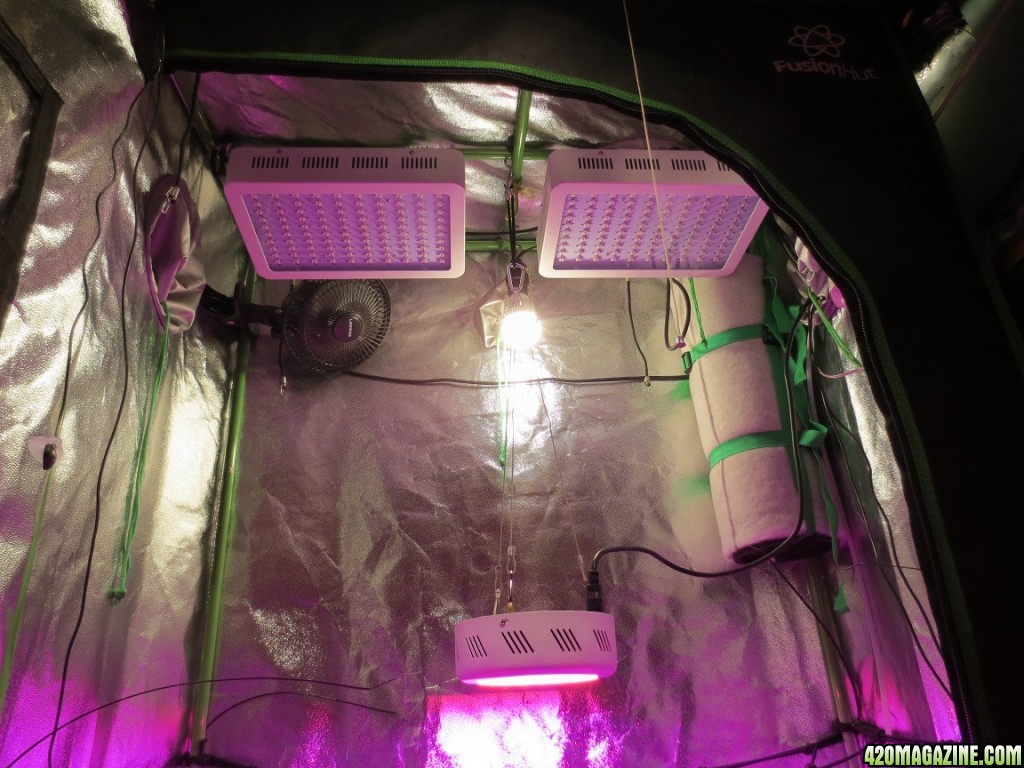
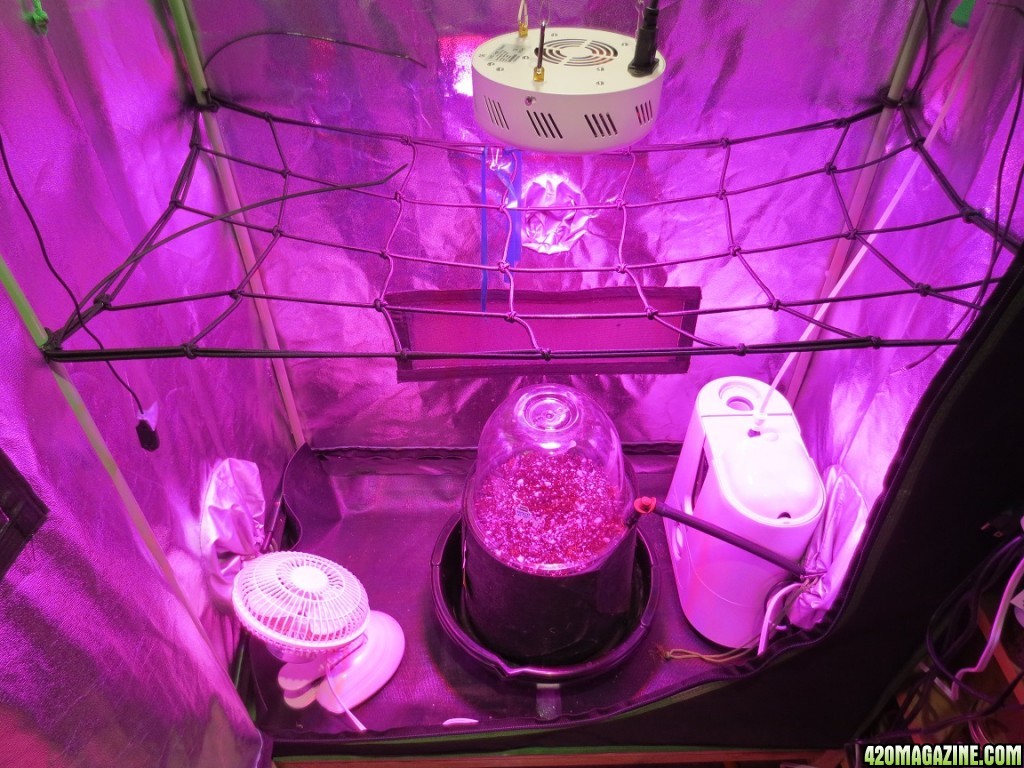
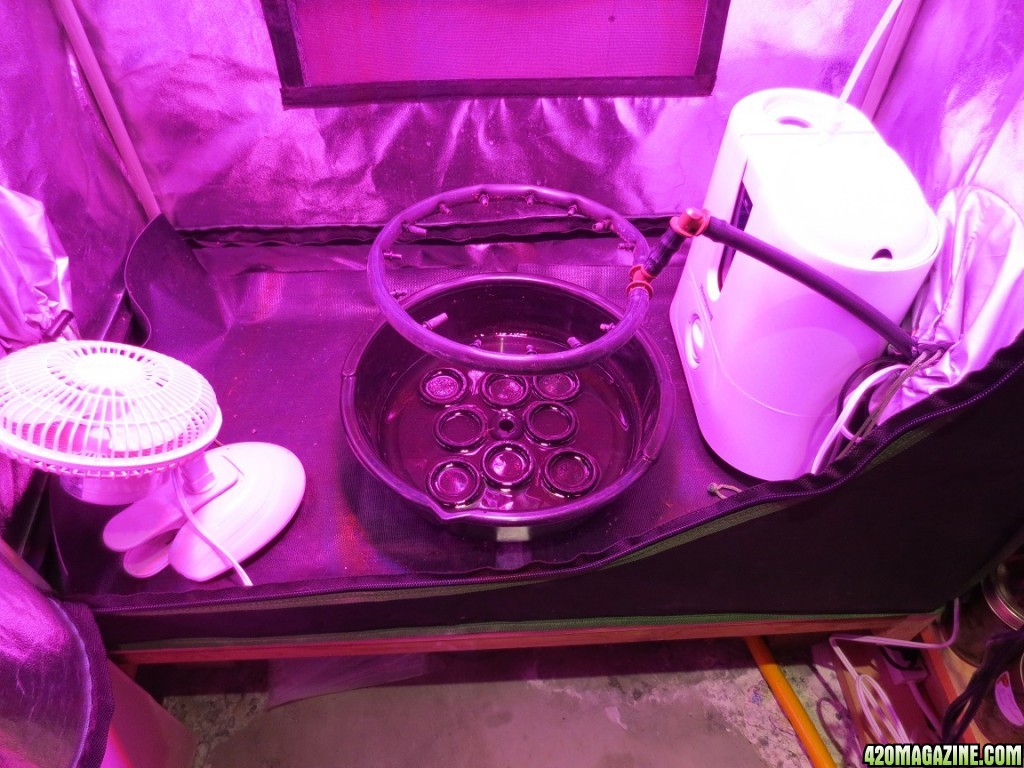
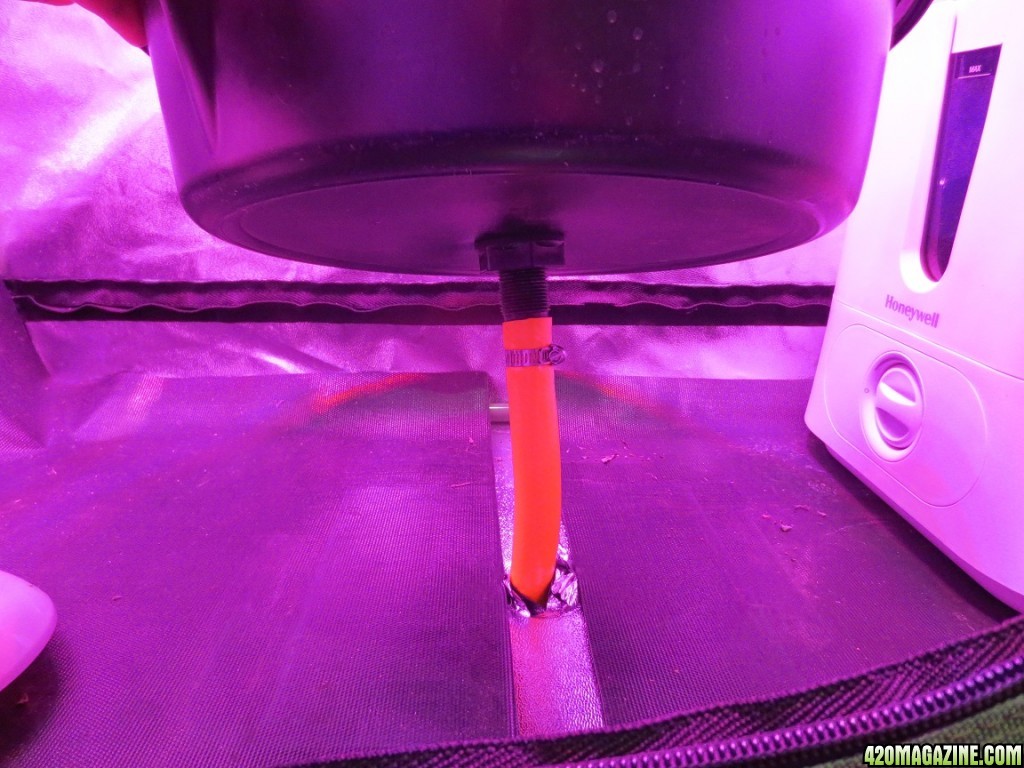
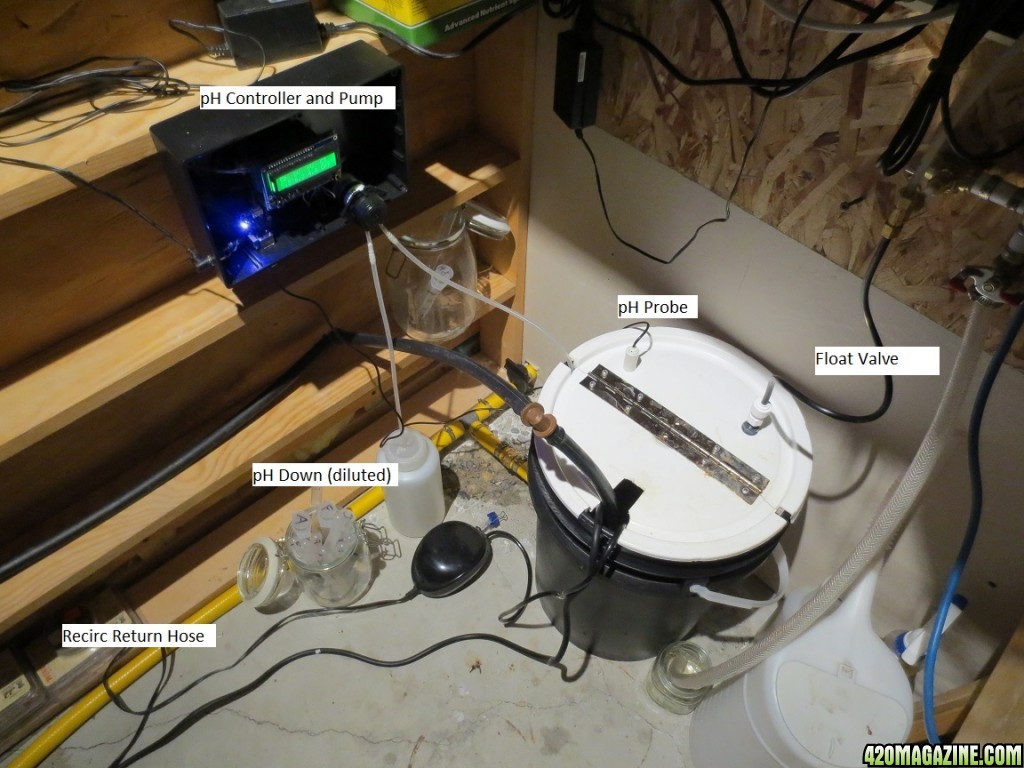
Scientific
New Member
Float valve, pH controller... man, that's slick! Thanks!
Stltoed
Well-Known Member
How did you build a ph controller?As promised here is my setup. I grow in a small 3x2x5 tent. It's a tough space to grow in, but I do OK. I have the tent up on a short table/platform and a hole cut in the bottom of the tent and table so the catch pan can sit right on the bottom, lights are as close to the top as I can get them (need all the growing space I can get). The catch pan is fitted with a flood/drain table drain nipple and the return hose comes out underneath. I have included a photo with the plant in place (just stuck a new seed in) and without the plant. In the photo without the plant you can see the irrigation ring (just made from Rainbird irrigation line and barbs) and the pan (just a fluid drain pan from auto store). I bucked off some rings from a PVC pipe to put in the pan and keep the pot out of and standing water in the bottom of the pan, though once the roots get down into it they suck any water up pretty quickly. My res is just a 5 gal bucket fitted with another flood table drain at the bottom on the side and I Tee off with another line and valve that goes through wall to a floor drain. I custom built a pH controller/pump, but an aquarium pH controller is probably easier for most. If you have any questions I'd be happy to answer.





Scientific
New Member
How did you build a ph controller?
Your monitor the pH of the solution with a pH probe. The pH monitoring circuit turns on a pump to add a weak acid solution when the pH starts to get too high.
Here's a super simple pH sensor: Building the Simplest Possible pH Meter • 66pacific.com
Here's kind of an interesting one for an aquarium, although technically it's controlling the amount of CO2 in the water by measuring how much the CO2 decreases the pH (by creating carbonic acid), it's also controlling the tank's pH by injecting CO2. pH Measurement & Control Circuit - Intro and Getting Started This seems like it might be fun to try for some kind of hybrid CO2/pH system?
RVCG, I'd be interested in seeing the details of yours, and to know about the float valve and what it's doing. Automatic water top-up?
Stltoed
Well-Known Member
That's wild. I've seen the stand alone units, even thought about getting one, but decided I don't want observe 1 one target value. That's pretty clever though. Besides, i actually like playing Ph police.Your monitor the pH of the solution with a pH probe. The pH monitoring circuit turns on a pump to add a weak acid solution when the pH starts to get too high.
Here's a super simple pH sensor: Building the Simplest Possible pH Meter - 66pacific.com
Here's kind of an interesting one for an aquarium, although technically it's controlling the amount of CO2 in the water by measuring how much the CO2 decreases the pH (by creating carbonic acid), it's also controlling the tank's pH by injecting CO2. pH Measurement & Control Circuit - Intro and Getting Started This seems like it might be fun to try for some kind of hybrid CO2/pH system?
RVCG, I'd be interested in seeing the details of yours, and to know about the float valve and what it's doing. Automatic water top-up?
- Thread starter
- #17
It's an Arduino based controller with a Gravity brand pH meter kit on an analog input, a relay shield to switch the pump signal on/off, and an LCD display with input buttons to run calibration, adjust settings, etc. The pump is a cheap eBay peristaltic pump. Nothing fancy, but was cheaper for me than buying something like a Milwaukee pH pump kit or a Bluelab pH controller.
Yes, float is for automatic water top-up. As mentioned above, I just drain and re-fill, nute up once a week and and leave it. Can't beat the convenience.
Yes, float is for automatic water top-up. As mentioned above, I just drain and re-fill, nute up once a week and and leave it. Can't beat the convenience.
- Thread starter
- #18
The way I programmed this one is it pH's down to say 5.5, but it won't redose until it climbs above 6.2, then redoses down to 5.5. The endpoints are actually adjustable with the buttons if I want it to bounce between say 5.7 and 6.3, etc. Most commercial units are setup the same was with an adjustable "deadband". I agree though I like to see it vary over a range, I think it's better for the plants (within reason of course too much pH swing can be a negative).
Stltoed
Well-Known Member
Ah, Arduino. Makes sense. I know a guy that makes custom billet cases for Arduino boards and components. Pretty interesting stuff. Very creative.It's an Arduino based controller with a Gravity brand pH meter kit on an analog input, a relay shield to switch the pump signal on/off, and an LCD display with input buttons to run calibration, adjust settings, etc. The pump is a cheap eBay peristaltic pump. Nothing fancy, but was cheaper for me than buying something like a Milwaukee pH pump kit or a Bluelab pH controller.
Yes, float is for automatic water top-up. As mentioned above, I just drain and re-fill, nute up once a week and and leave it. Can't beat the convenience.
Scientific
New Member
i actually like playing Ph police.
Then you would have loved my little hydroponic grow. I was chasing the pH all over the place. (I think it was because my reservoir was too small.)
Similar threads
- Replies
- 3
- Views
- 2K
- Replies
- 28
- Views
- 1K
- Replies
- 1
- Views
- 670


